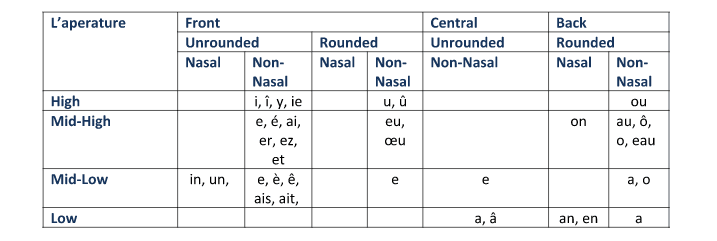French vowel sounds got you feeling tongue-tied? Tutor Tyler S. shares his best tips to proper French pronunciation…
Everyone faces their own personal challenges when learning a foreign language, and I remember that mastering the French vowel system was a great challenge for me. French pronunciation uses approximately 15 vowels, and it uses sounds that English doesn’t include. There are extensive books dedicated to describing these vowels, but you don’t need to be an expert to use French vowels like a native speaker. In this article, I recommend a few basic French vowel pronunciation rules to follow.
French vowel pronunciation can be tricky, but with a little practice it’s easy to get the hang of. In this article, we’ll give you some tips for mastering French vowels. So whether you’re a beginner or an advanced speaker, read on for some helpful advice!
What Are the 7 Vowels in French?
There are only seven basic vowel sounds in French:
- /a/
- /ɛ/
- /ə/
- /i/
- /o/
- /u/
- /y/
French vowels can be grueling to learn at first, as there are multiple ways to pronounce each one! A single French vowel can have several different sounds, depending on the other letters present in the word.
Each of these vowels has a unique sound, and once you know how to pronounce them, you’ll be well on your way to mastering French vowel pronunciation!
Not sure how to get started learning French vowels pronunciation? Signing up for French lessons can help, as can watching educational videos like the one you see below:
https://www.youtube.com/watch?v=oIL8XYFImm8
How Many Vowel Sounds Are in French?
When you are learning vowels in French pronunciation, it is important to remember that although there are seven vowels, there are many more vowel sounds.
French has 12 vowel sounds, which can be divided into two groups: oral vowels and nasal vowels. Oral vowels are pronounced with the mouth open, while nasal vowels are pronounced with the nose open.
There are also four dipthongs, which are two vowel sounds that are pronounced together. French vowel sounds are unique in that they are not affected by the following consonant, as they are in English.
This means that the same vowel sound can be pronounced differently depending on the surrounding letters. For example, the “e” in “les” is pronounced differently than the “e” in “temps.”
As a result, learning to pronounce French vowels can be a challenge for English speakers. However, with a little practice, it is possible to produce all 12 of the French vowel sounds.
How Do You Pronounce French Vowels?
By paying attention to these fundamental tips, your foreign accent in French will gradually disappear, and you will be able to converse like a fluent speaker with ease!
Learn everything you need to know about basic French pronunciation vowels in this detailed French vowel pronunciation guide.
1. Understand What a Vowel Actually Is
It was very frustrating for me to be corrected over and over again in French class when I didn’t understand why or how I was making mistakes in my pronunciation. It was not until I took a phonetics course in college that I was able to finally understand how to fine-tune my French pronunciation.
There are four key defining “characteristics” of sound that each French vowel symbolizes:
1. L’aperature – This correlates to the “height” of a speaker’s tongue. A “high” vowel is pronounced with your tongue located close to roof of your mouth, whereas a “low” vowel requires you to keep your tongue located close to the bottom of your mouth.
2. L’antériorité – This correlates to the “backness” of your tongue. A “back” vowel means your tongue is positioned close to the back of your throat versus a “front” vowel, which means your tongue is located close to your mouth’s opening.
3. La rondissement – Literally meaning “roundness,” this term signifies whether or not your lips are rounded when articulating a vowel.
4. La nasalité – Some vowels are pronounced through the nasal cavity. This means that air flows through both your mouth and through the passageway that connects your throat to your nose. There are three nasal vowels in French. (I’ll tell you more about pronunciation French vowels like these later on in the post).
Each vowel in French contains a unique combination of the four characteristics mentioned above. For example, the characteristics of the vowel written “u” in French can be summarized as follows:
u = (high, front, rounded, non-nasal vowel)
Hearing the combination of these four characteristics is what makes a listener know, “Oh, that speaker just used the sound [u] in that word!” Every French vowel has a combination. Using these guidelines, you can figure out where your mouth, tongue and lips should be when you pronounce a vowel.
Here is my favorite video on French Vowel Phonetics for you if you want more information:
2. Learn Pronunciation With Spelling
Now that you understand the four characteristics of sound that French uses to create vowels, you can then begin training your brain to read French. French is a non-phonetic language that has complex spelling rules, which basically means that it’s not always spoken how it is written.
Sometimes, three written vowels such as “eau” in French equal merely one spoken vowel, and sometimes a vowel sound can be represented by a single vowel. You have to work to memorize what sequences of letters create what spoken sound if you want to be able to speak, read and write French correctly.
I included a table I created of common French spellings for its vowels. This is so that you can associate each individual pronunciation of a vowel with how it is spelled in French. For example, if you have been pronouncing the written vowels “ou” and “u” the same, then you can use this table to see that “ou” is pronounced with your tongue positioned at the back of your mouth, whereas “u” is pronounced with your tongue positioned at the front of your mouth, but both sounds are high vowels (the tongue is close to the roof of your mouth for both vowels). All spellings within a single box represent a single vowel, and so you can see that all spellings within a box are pronounced the same.

3. Nasal Vowels in French
You also need to master the French nasal vowels pronunciation.
French has a variety of nasal vowels, which are produced when air escapes through the nose as well as the mouth. The most common French nasal vowels are /ɛ̃/, /œ̃/, and /ɑ̃/. These sounds can be difficult for English speakers to produce, as they require the soft palate to be lowered while the velum is raised.
This process is known as velarization. In addition to velarization, nasal vowels in French often undergo a process called assimilation, whereby they take on characteristics of the following consonant sound.
For example, the word un (/œ̃/) is usually pronounced /œ̃n/ before a nasal consonant such as /m/ or /n/. Assimilation can also occur with non-nasal consonants, as in the word bonjour (/bɔ̃ʒuʁ/), which is typically pronounced /bɔ̃ʒuʁ/.
By understanding how to produce and assimilate French nasal vowels, English speakers can improve their pronunciation and communication skills.
4. Practice Makes Perfect
This is where many students of French drop the ball. You now have the tools you need to fine-tune your pronunciation, and you have the tools to figure out what spellings match up with each vowel. However, we have to tie the two together to be able to read, speak and write French correctly. There’s no way around accomplishing this task than to practice listening to each vowel, repeating that vowel, comparing your pronunciation to what you heard and physically seeing the vowel’s spelling.
To keep practicing, you can watch more videos about French pronunciation on YouTube. Here’s one of my favorites-
French Vowels and Consonants Pronunciation: Start Learning Today
If you are serious about learning French, I would practice at least three times a week. It won’t be long before you notice that you have more confidence in your speech and that you can understand how to correct your pronunciation. It takes weeks or months to become a master of French vowels, but you will be proud and feel accomplished when you realize that your efforts took your French from a beginner’s level to the advanced level.
For more help with French pronunciation, vocabulary, and grammar, taking private lessons with French tutor is the best way to make progress fast! French tutors are available to work with you online via Skype or in-person depending on locations and availability. Search for your French tutor now!
Tyler S. teaches in-person Spanish and French lessons in Minneapolis, MN. He received his Bachelor’s degree in German and linguistics from the University of Minnesota, and has experience working as a teaching assistant and private tutor with TakeLessons since 2008. What’s more? He can speak 7 different languages! Learn more about Tyler here!
Photo by Luka Knezevic – Strika
Megan L.


